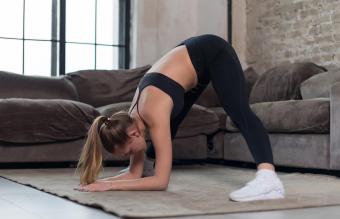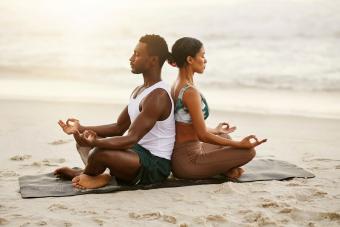
You can perform partner yoga with a friend, a fellow yogi in class, or with a special partner. There are many poses that can facilitate your emotional bond and physical awareness. Warrior 3 Pose and Tree Pose increase strength, balance, and trust, while Assisted Child's Pose helps partners go deeper into the posture than they may on their own.
Partner Warrior 3 Pose
Warrior 3 is a strong posture that requires balance and strength through the legs. Practicing it with a partner can develop trust between two people as you move slowly and maintain an upright stance.
- Stand facing your partner. Hold each other's shoulders.
- Walk away from each other and bend at the waist until your bodies are at a right angle to each other. Feel length in the spine, while maintining a grounding through the feet. Bend your knees gently for additional stabililty.
- Both partners raise one leg, coming into Warrior 3. Keep the toes pointed to the floor and the hips square.
- When you are ready to come out of the pose, squeeze your partner's shoulder. Walk towards each other as you stand up to come out of the posture.
Partner Tree Pose
Tree Pose is another balance posture that develops confidence and focus. As you ground through your feet, you can stand as two trees next to each other, or bend like two trees in the wind.
- Stand close to one another. Draw your hands into prayer pose in front of your heart.
- Find your weight on one leg (the leg closest to your partner) and begin to lift the outside foot. Place your outside foot on your calf or thigh. Avoid placing the foot on the knee.
- Once you feel steady in your Tree Pose, play with connecting to the person next to you. Draw your inside arms up and reach your palms together. Take your outside hands and draw them together at the midline between your two bodies, joining your hands together to create prayer hands.
- Come out of the pose slowly, maintaining your balance, and eventually returning the outside foot to the floor.
Assisted Child's Pose
Practicing Child's Pose is always relaxing, and with the help of the partner this posture becomes even more soothing. The person in Child's Pose receives weight while the partner on top can open into a freeing backbend.
- One person can come into Child's Pose. If Child's Pose is already an intense posture for your knees or hips, then the Assisted Child's Pose variation may not be for you.
- To come into the Assisted Child's Pose variation, your partner should stand at your feet, facing away from you. The partner will sit down onto your hips. Partners should always communicate verbally and ask if the pressure feels okay.
- Have them sit down onto your hips, asking them if the pressure feels okay for your body. The partner should stay here, or lean back onto their spine, opening the heart for a backbend. When finished, roll to one side and then come up. The person in child's pose should rise slowly as they come out of the posture.
Full Partner Flow Sequence
If you're looking for a comprehensive partner flow, this ten-minute guided sequence from Sadie Nardini features partners practicing in unison. It includes partner poses for Downward Facing Dog, Cobra Pose, Warrior 2, Chair Pose, Janu Sirsasana, Wide Angle, Dandasana, and Forward Bend.
General Guidelines of Partnering
When you team up with another yogi, keep in mind that everyone has a different level of skill and flexibility. There may also be some underlying conditions, such as back injuries, problems with carpal tunnel, and other maladies that prohibit individuals from performing the same postures. Take the time to review some basic asanas with one another, such as the foundational ones found in Hatha yoga. After practicing poses familiar to both of you, move on to poses that are more challenging to do with someone by your side. Always respect the body's limitations, and never force a pose. Remember, the overall goal of performing yoga together is the improved mental, physical, and emotional well-being of everyone involved.
Partner yoga can also be referred to as Cupid Yoga. Yoga instructor Ryan Chester talks about the benefits of this form of yoga for pairs.
Locate a Partner Class Near You
Look on Yoga Finder to find classes that perform partner yoga, or put out a query on Yoga Meetup to see if anyone else is interested. A group of potential partner session attendees joining together is strong persuasion for any local studio to create a class and make it worthwhile. Many yoga instructors also conduct one-on-one sessions to perfect a pose and enhance the overall experience.
Discover Your Own Two-Person Yoga Poses
You can modify almost all yoga poses to practice with a partner or simply practice alongside a partner using syncronized breath. Partners can assist one another with challenging asanas or provide touch and massage to relax the body. Be mindful that you don't push someone past their limits, and also listen to your own inner voice about what feels safe for your body. Yoga is a non-competative activity and is meant to encourage trust and open communication with your yoga partner. With an open, beginner's mind, practicing partner yoga can provide a new challenge or spiritual experience for even the most basic yoga poses.







